Organizational Analysis: ASOS Plc's CEO, Leadership, and Management
VerifiedAdded on 2022/11/30
|11
|3711
|434
Report
AI Summary
This report provides a comprehensive analysis of ASOS Plc, focusing on its organizational theory and practice. It begins by defining organizational theory and introducing ASOS Plc, highlighting its CEO, Nick Beighton. The report examines the CEO's managerial style through the lens of Henry Mintzberg's managerial roles (interpersonal, informational, and decisional). It then analyzes the steps taken by the CEO to implement organizational changes, particularly in response to the pandemic, and the resulting cultural impacts. The report also explores the CEO's leadership style, identifying it as innovative leadership and its role in enhancing organizational efficiency. Furthermore, it describes the effects of power, influence, and conflict within ASOS Plc, and discusses the motivational strategies employed. The report concludes by suggesting recommendations based on corporate examples and relevant literature, offering insights into ASOS Plc's management and organizational behavior.
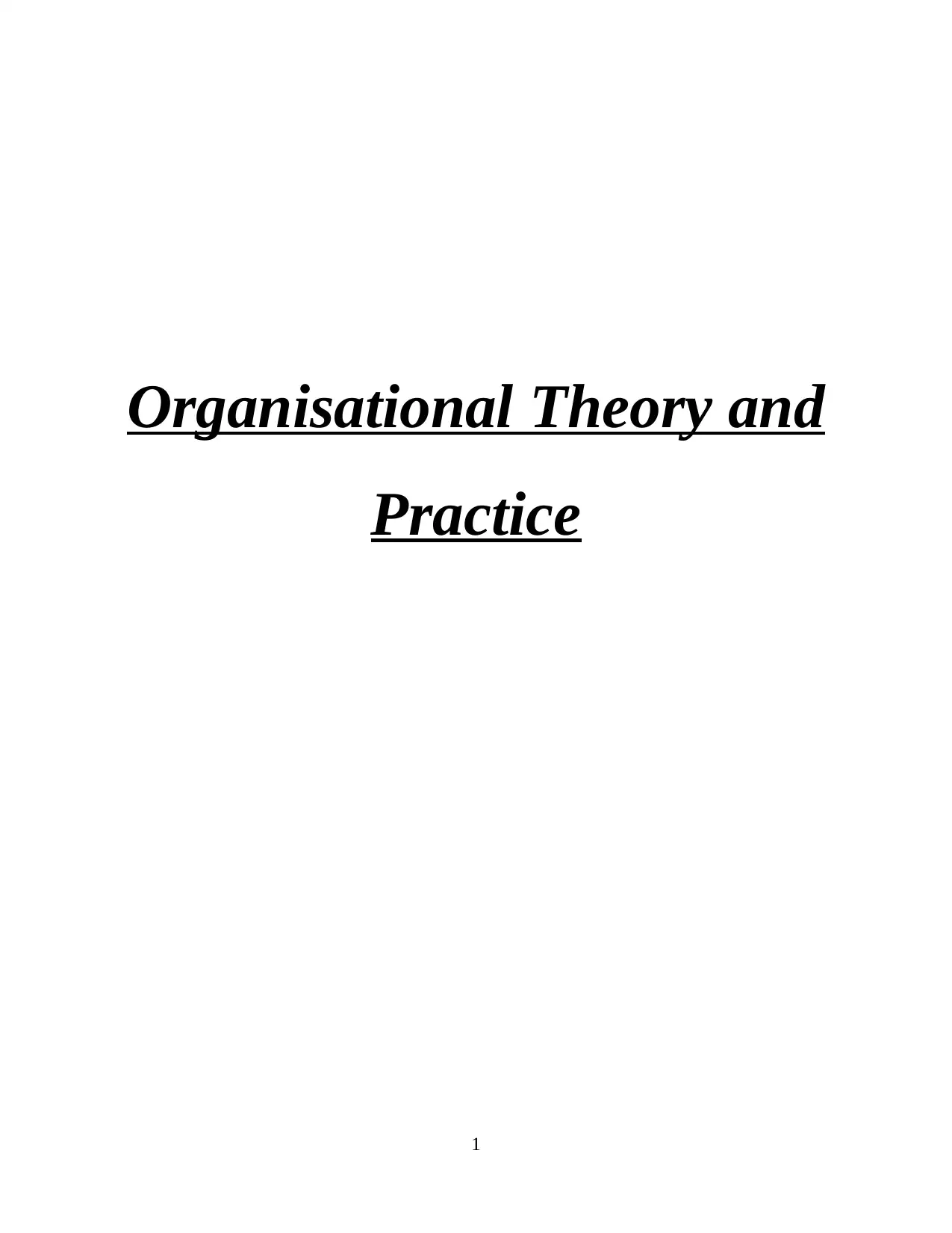
Organisational Theory and
Practice
1
Practice
1
Paraphrase This Document
Need a fresh take? Get an instant paraphrase of this document with our AI Paraphraser
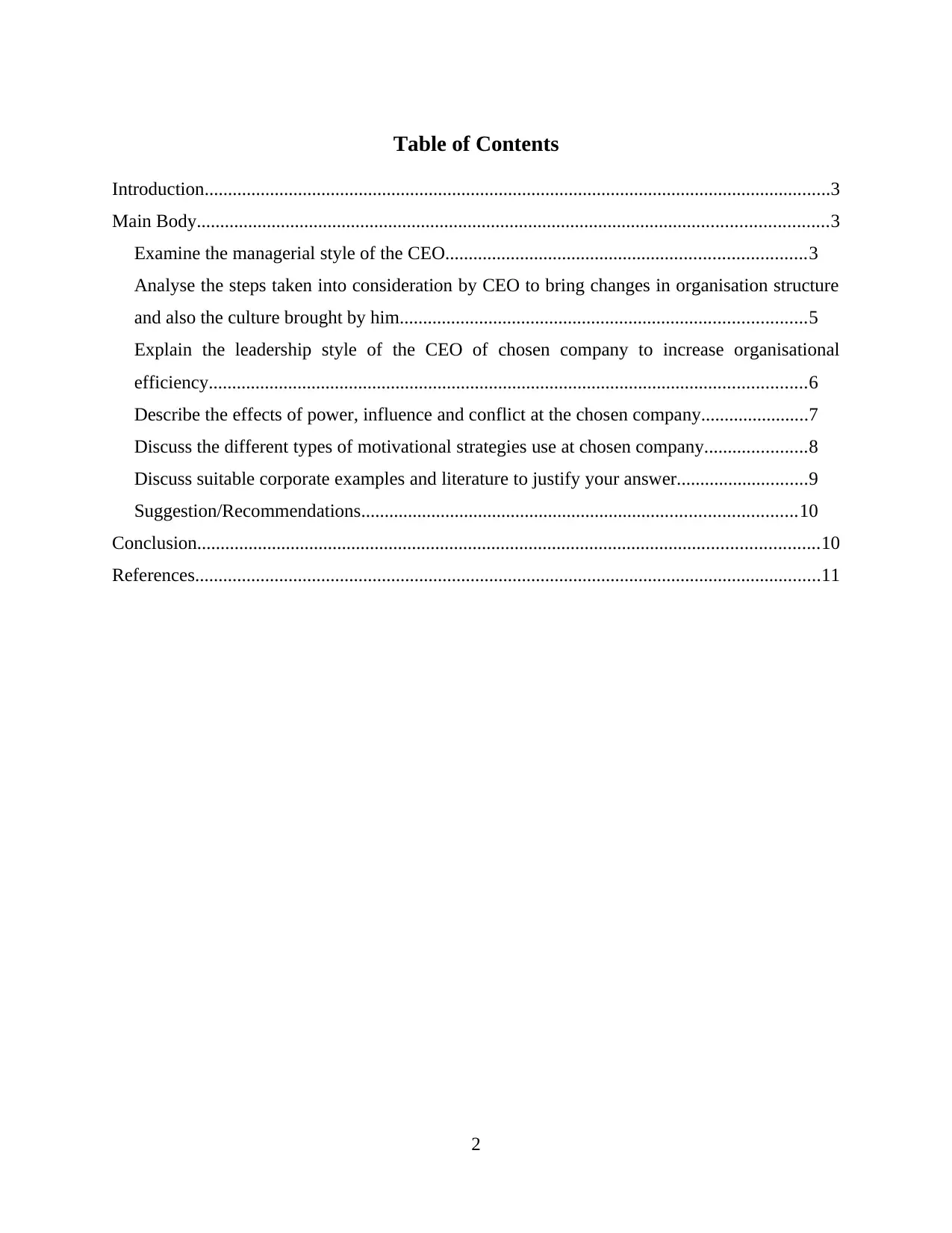
Table of Contents
Introduction......................................................................................................................................3
Main Body.......................................................................................................................................3
Examine the managerial style of the CEO.............................................................................3
Analyse the steps taken into consideration by CEO to bring changes in organisation structure
and also the culture brought by him.......................................................................................5
Explain the leadership style of the CEO of chosen company to increase organisational
efficiency................................................................................................................................6
Describe the effects of power, influence and conflict at the chosen company.......................7
Discuss the different types of motivational strategies use at chosen company......................8
Discuss suitable corporate examples and literature to justify your answer............................9
Suggestion/Recommendations.............................................................................................10
Conclusion.....................................................................................................................................10
References......................................................................................................................................11
2
Introduction......................................................................................................................................3
Main Body.......................................................................................................................................3
Examine the managerial style of the CEO.............................................................................3
Analyse the steps taken into consideration by CEO to bring changes in organisation structure
and also the culture brought by him.......................................................................................5
Explain the leadership style of the CEO of chosen company to increase organisational
efficiency................................................................................................................................6
Describe the effects of power, influence and conflict at the chosen company.......................7
Discuss the different types of motivational strategies use at chosen company......................8
Discuss suitable corporate examples and literature to justify your answer............................9
Suggestion/Recommendations.............................................................................................10
Conclusion.....................................................................................................................................10
References......................................................................................................................................11
2
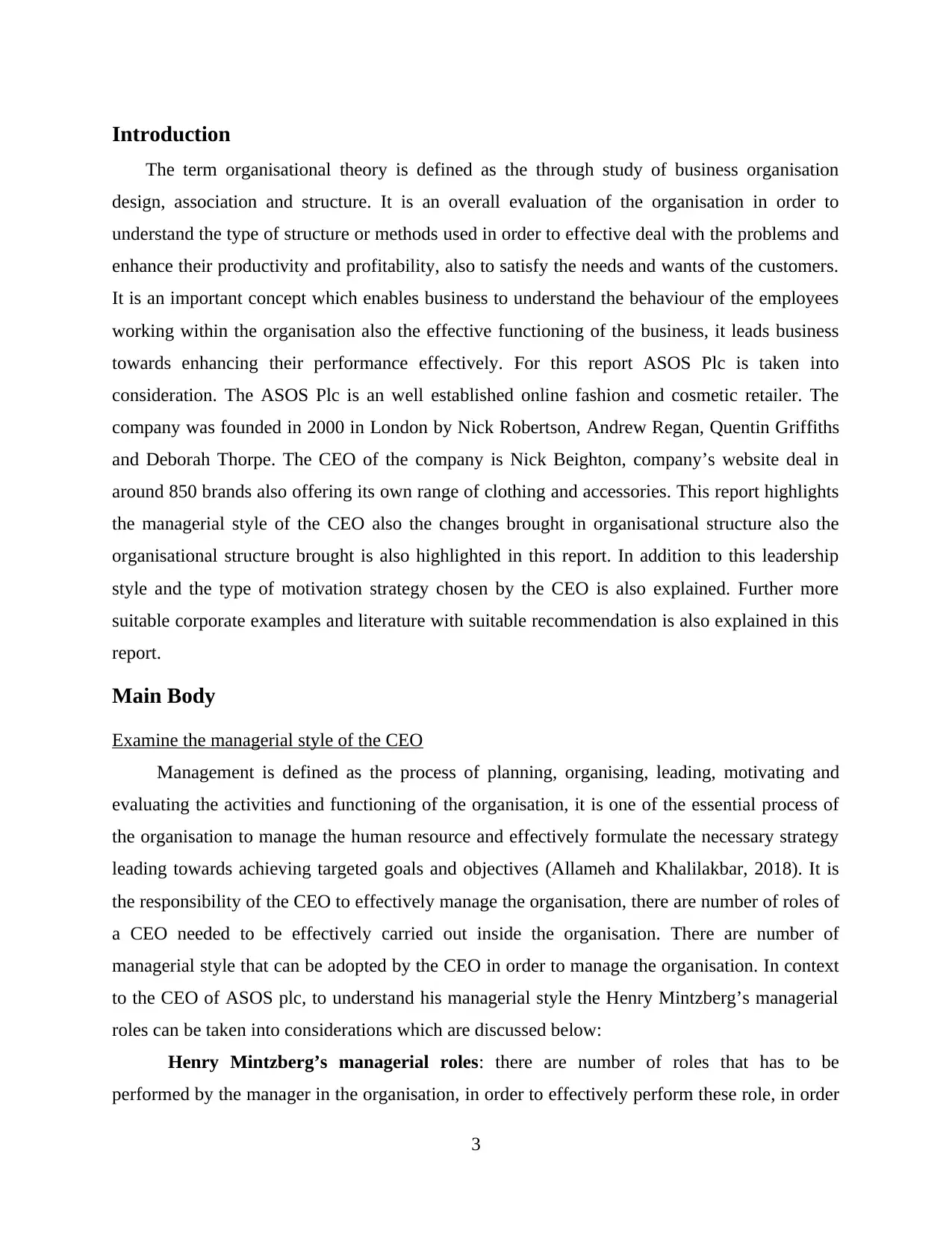
Introduction
The term organisational theory is defined as the through study of business organisation
design, association and structure. It is an overall evaluation of the organisation in order to
understand the type of structure or methods used in order to effective deal with the problems and
enhance their productivity and profitability, also to satisfy the needs and wants of the customers.
It is an important concept which enables business to understand the behaviour of the employees
working within the organisation also the effective functioning of the business, it leads business
towards enhancing their performance effectively. For this report ASOS Plc is taken into
consideration. The ASOS Plc is an well established online fashion and cosmetic retailer. The
company was founded in 2000 in London by Nick Robertson, Andrew Regan, Quentin Griffiths
and Deborah Thorpe. The CEO of the company is Nick Beighton, company’s website deal in
around 850 brands also offering its own range of clothing and accessories. This report highlights
the managerial style of the CEO also the changes brought in organisational structure also the
organisational structure brought is also highlighted in this report. In addition to this leadership
style and the type of motivation strategy chosen by the CEO is also explained. Further more
suitable corporate examples and literature with suitable recommendation is also explained in this
report.
Main Body
Examine the managerial style of the CEO
Management is defined as the process of planning, organising, leading, motivating and
evaluating the activities and functioning of the organisation, it is one of the essential process of
the organisation to manage the human resource and effectively formulate the necessary strategy
leading towards achieving targeted goals and objectives (Allameh and Khalilakbar, 2018). It is
the responsibility of the CEO to effectively manage the organisation, there are number of roles of
a CEO needed to be effectively carried out inside the organisation. There are number of
managerial style that can be adopted by the CEO in order to manage the organisation. In context
to the CEO of ASOS plc, to understand his managerial style the Henry Mintzberg’s managerial
roles can be taken into considerations which are discussed below:
Henry Mintzberg’s managerial roles: there are number of roles that has to be
performed by the manager in the organisation, in order to effectively perform these role, in order
3
The term organisational theory is defined as the through study of business organisation
design, association and structure. It is an overall evaluation of the organisation in order to
understand the type of structure or methods used in order to effective deal with the problems and
enhance their productivity and profitability, also to satisfy the needs and wants of the customers.
It is an important concept which enables business to understand the behaviour of the employees
working within the organisation also the effective functioning of the business, it leads business
towards enhancing their performance effectively. For this report ASOS Plc is taken into
consideration. The ASOS Plc is an well established online fashion and cosmetic retailer. The
company was founded in 2000 in London by Nick Robertson, Andrew Regan, Quentin Griffiths
and Deborah Thorpe. The CEO of the company is Nick Beighton, company’s website deal in
around 850 brands also offering its own range of clothing and accessories. This report highlights
the managerial style of the CEO also the changes brought in organisational structure also the
organisational structure brought is also highlighted in this report. In addition to this leadership
style and the type of motivation strategy chosen by the CEO is also explained. Further more
suitable corporate examples and literature with suitable recommendation is also explained in this
report.
Main Body
Examine the managerial style of the CEO
Management is defined as the process of planning, organising, leading, motivating and
evaluating the activities and functioning of the organisation, it is one of the essential process of
the organisation to manage the human resource and effectively formulate the necessary strategy
leading towards achieving targeted goals and objectives (Allameh and Khalilakbar, 2018). It is
the responsibility of the CEO to effectively manage the organisation, there are number of roles of
a CEO needed to be effectively carried out inside the organisation. There are number of
managerial style that can be adopted by the CEO in order to manage the organisation. In context
to the CEO of ASOS plc, to understand his managerial style the Henry Mintzberg’s managerial
roles can be taken into considerations which are discussed below:
Henry Mintzberg’s managerial roles: there are number of roles that has to be
performed by the manager in the organisation, in order to effectively perform these role, in order
3
⊘ This is a preview!⊘
Do you want full access?
Subscribe today to unlock all pages.

Trusted by 1+ million students worldwide
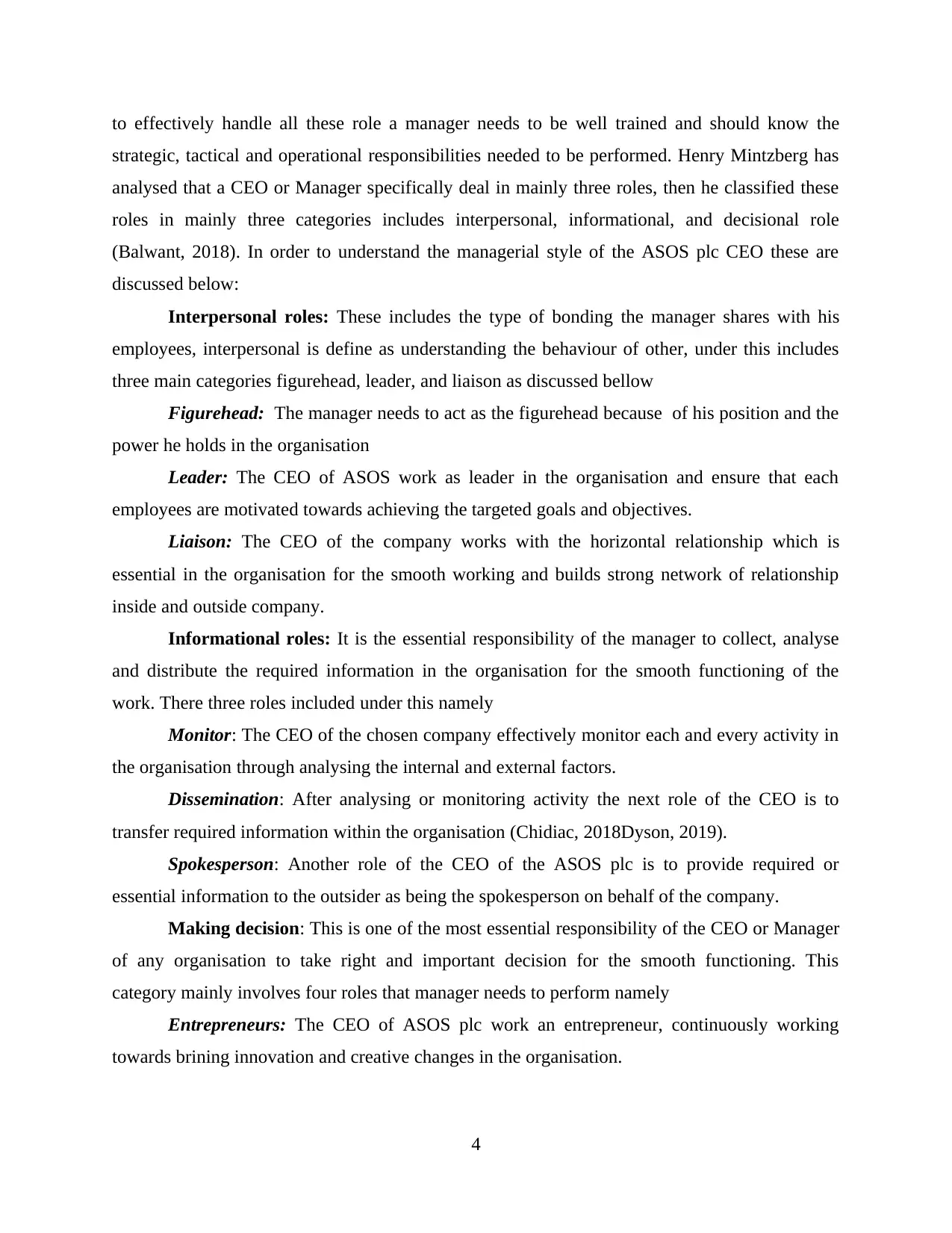
to effectively handle all these role a manager needs to be well trained and should know the
strategic, tactical and operational responsibilities needed to be performed. Henry Mintzberg has
analysed that a CEO or Manager specifically deal in mainly three roles, then he classified these
roles in mainly three categories includes interpersonal, informational, and decisional role
(Balwant, 2018). In order to understand the managerial style of the ASOS plc CEO these are
discussed below:
Interpersonal roles: These includes the type of bonding the manager shares with his
employees, interpersonal is define as understanding the behaviour of other, under this includes
three main categories figurehead, leader, and liaison as discussed bellow
Figurehead: The manager needs to act as the figurehead because of his position and the
power he holds in the organisation
Leader: The CEO of ASOS work as leader in the organisation and ensure that each
employees are motivated towards achieving the targeted goals and objectives.
Liaison: The CEO of the company works with the horizontal relationship which is
essential in the organisation for the smooth working and builds strong network of relationship
inside and outside company.
Informational roles: It is the essential responsibility of the manager to collect, analyse
and distribute the required information in the organisation for the smooth functioning of the
work. There three roles included under this namely
Monitor: The CEO of the chosen company effectively monitor each and every activity in
the organisation through analysing the internal and external factors.
Dissemination: After analysing or monitoring activity the next role of the CEO is to
transfer required information within the organisation (Chidiac, 2018Dyson, 2019).
Spokesperson: Another role of the CEO of the ASOS plc is to provide required or
essential information to the outsider as being the spokesperson on behalf of the company.
Making decision: This is one of the most essential responsibility of the CEO or Manager
of any organisation to take right and important decision for the smooth functioning. This
category mainly involves four roles that manager needs to perform namely
Entrepreneurs: The CEO of ASOS plc work an entrepreneur, continuously working
towards brining innovation and creative changes in the organisation.
4
strategic, tactical and operational responsibilities needed to be performed. Henry Mintzberg has
analysed that a CEO or Manager specifically deal in mainly three roles, then he classified these
roles in mainly three categories includes interpersonal, informational, and decisional role
(Balwant, 2018). In order to understand the managerial style of the ASOS plc CEO these are
discussed below:
Interpersonal roles: These includes the type of bonding the manager shares with his
employees, interpersonal is define as understanding the behaviour of other, under this includes
three main categories figurehead, leader, and liaison as discussed bellow
Figurehead: The manager needs to act as the figurehead because of his position and the
power he holds in the organisation
Leader: The CEO of ASOS work as leader in the organisation and ensure that each
employees are motivated towards achieving the targeted goals and objectives.
Liaison: The CEO of the company works with the horizontal relationship which is
essential in the organisation for the smooth working and builds strong network of relationship
inside and outside company.
Informational roles: It is the essential responsibility of the manager to collect, analyse
and distribute the required information in the organisation for the smooth functioning of the
work. There three roles included under this namely
Monitor: The CEO of the chosen company effectively monitor each and every activity in
the organisation through analysing the internal and external factors.
Dissemination: After analysing or monitoring activity the next role of the CEO is to
transfer required information within the organisation (Chidiac, 2018Dyson, 2019).
Spokesperson: Another role of the CEO of the ASOS plc is to provide required or
essential information to the outsider as being the spokesperson on behalf of the company.
Making decision: This is one of the most essential responsibility of the CEO or Manager
of any organisation to take right and important decision for the smooth functioning. This
category mainly involves four roles that manager needs to perform namely
Entrepreneurs: The CEO of ASOS plc work an entrepreneur, continuously working
towards brining innovation and creative changes in the organisation.
4
Paraphrase This Document
Need a fresh take? Get an instant paraphrase of this document with our AI Paraphraser
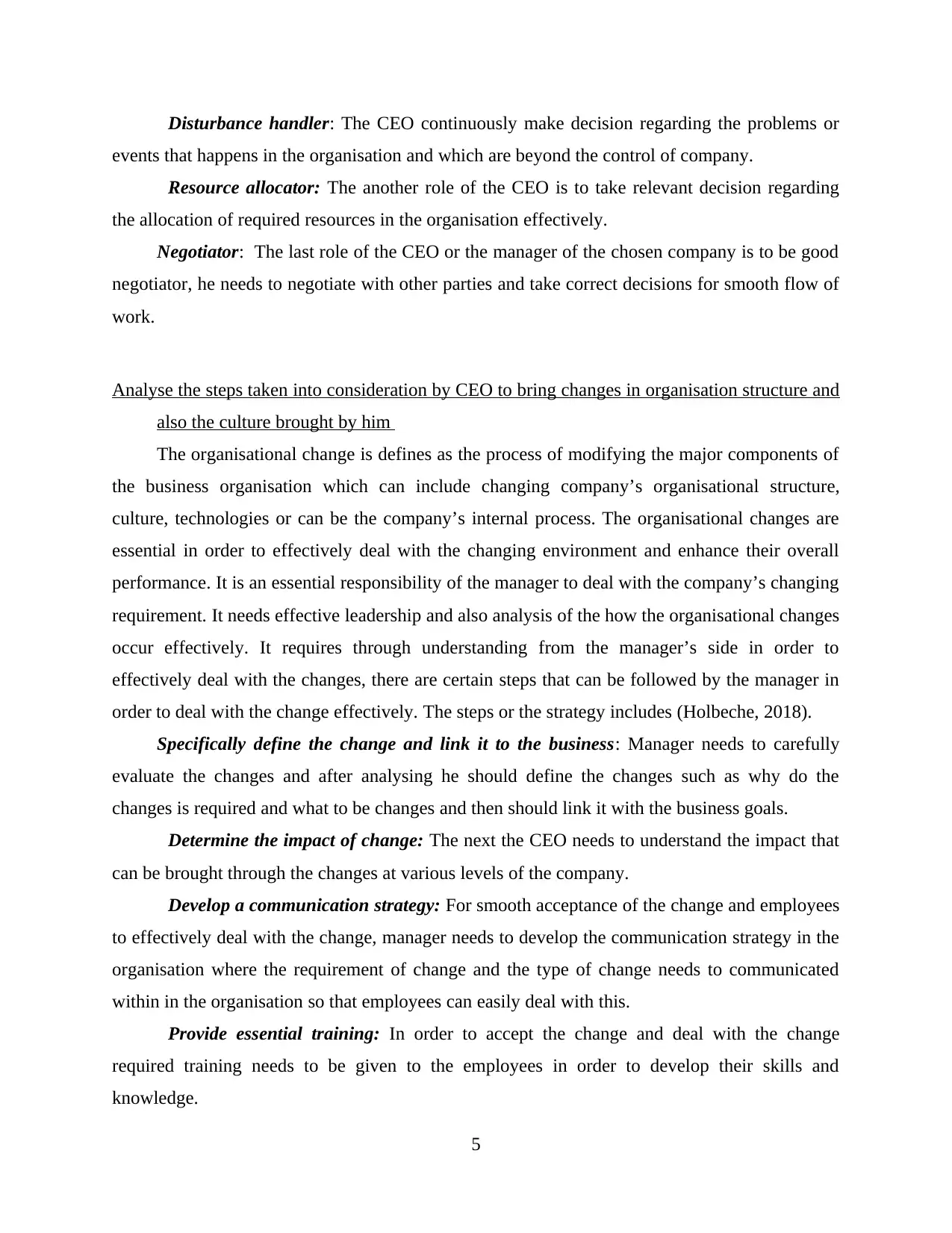
Disturbance handler: The CEO continuously make decision regarding the problems or
events that happens in the organisation and which are beyond the control of company.
Resource allocator: The another role of the CEO is to take relevant decision regarding
the allocation of required resources in the organisation effectively.
Negotiator: The last role of the CEO or the manager of the chosen company is to be good
negotiator, he needs to negotiate with other parties and take correct decisions for smooth flow of
work.
Analyse the steps taken into consideration by CEO to bring changes in organisation structure and
also the culture brought by him
The organisational change is defines as the process of modifying the major components of
the business organisation which can include changing company’s organisational structure,
culture, technologies or can be the company’s internal process. The organisational changes are
essential in order to effectively deal with the changing environment and enhance their overall
performance. It is an essential responsibility of the manager to deal with the company’s changing
requirement. It needs effective leadership and also analysis of the how the organisational changes
occur effectively. It requires through understanding from the manager’s side in order to
effectively deal with the changes, there are certain steps that can be followed by the manager in
order to deal with the change effectively. The steps or the strategy includes (Holbeche, 2018).
Specifically define the change and link it to the business: Manager needs to carefully
evaluate the changes and after analysing he should define the changes such as why do the
changes is required and what to be changes and then should link it with the business goals.
Determine the impact of change: The next the CEO needs to understand the impact that
can be brought through the changes at various levels of the company.
Develop a communication strategy: For smooth acceptance of the change and employees
to effectively deal with the change, manager needs to develop the communication strategy in the
organisation where the requirement of change and the type of change needs to communicated
within in the organisation so that employees can easily deal with this.
Provide essential training: In order to accept the change and deal with the change
required training needs to be given to the employees in order to develop their skills and
knowledge.
5
events that happens in the organisation and which are beyond the control of company.
Resource allocator: The another role of the CEO is to take relevant decision regarding
the allocation of required resources in the organisation effectively.
Negotiator: The last role of the CEO or the manager of the chosen company is to be good
negotiator, he needs to negotiate with other parties and take correct decisions for smooth flow of
work.
Analyse the steps taken into consideration by CEO to bring changes in organisation structure and
also the culture brought by him
The organisational change is defines as the process of modifying the major components of
the business organisation which can include changing company’s organisational structure,
culture, technologies or can be the company’s internal process. The organisational changes are
essential in order to effectively deal with the changing environment and enhance their overall
performance. It is an essential responsibility of the manager to deal with the company’s changing
requirement. It needs effective leadership and also analysis of the how the organisational changes
occur effectively. It requires through understanding from the manager’s side in order to
effectively deal with the changes, there are certain steps that can be followed by the manager in
order to deal with the change effectively. The steps or the strategy includes (Holbeche, 2018).
Specifically define the change and link it to the business: Manager needs to carefully
evaluate the changes and after analysing he should define the changes such as why do the
changes is required and what to be changes and then should link it with the business goals.
Determine the impact of change: The next the CEO needs to understand the impact that
can be brought through the changes at various levels of the company.
Develop a communication strategy: For smooth acceptance of the change and employees
to effectively deal with the change, manager needs to develop the communication strategy in the
organisation where the requirement of change and the type of change needs to communicated
within in the organisation so that employees can easily deal with this.
Provide essential training: In order to accept the change and deal with the change
required training needs to be given to the employees in order to develop their skills and
knowledge.
5
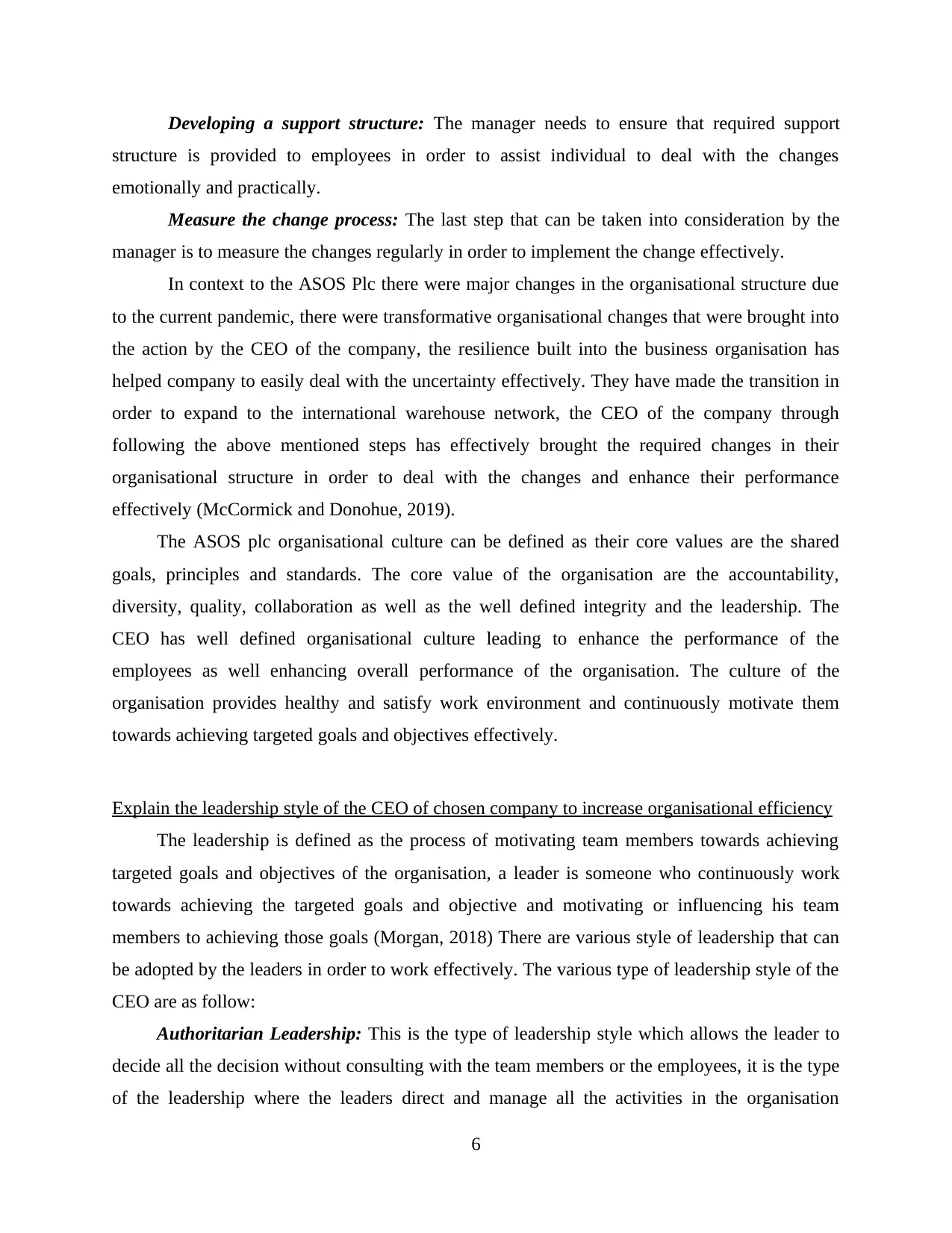
Developing a support structure: The manager needs to ensure that required support
structure is provided to employees in order to assist individual to deal with the changes
emotionally and practically.
Measure the change process: The last step that can be taken into consideration by the
manager is to measure the changes regularly in order to implement the change effectively.
In context to the ASOS Plc there were major changes in the organisational structure due
to the current pandemic, there were transformative organisational changes that were brought into
the action by the CEO of the company, the resilience built into the business organisation has
helped company to easily deal with the uncertainty effectively. They have made the transition in
order to expand to the international warehouse network, the CEO of the company through
following the above mentioned steps has effectively brought the required changes in their
organisational structure in order to deal with the changes and enhance their performance
effectively (McCormick and Donohue, 2019).
The ASOS plc organisational culture can be defined as their core values are the shared
goals, principles and standards. The core value of the organisation are the accountability,
diversity, quality, collaboration as well as the well defined integrity and the leadership. The
CEO has well defined organisational culture leading to enhance the performance of the
employees as well enhancing overall performance of the organisation. The culture of the
organisation provides healthy and satisfy work environment and continuously motivate them
towards achieving targeted goals and objectives effectively.
Explain the leadership style of the CEO of chosen company to increase organisational efficiency
The leadership is defined as the process of motivating team members towards achieving
targeted goals and objectives of the organisation, a leader is someone who continuously work
towards achieving the targeted goals and objective and motivating or influencing his team
members to achieving those goals (Morgan, 2018) There are various style of leadership that can
be adopted by the leaders in order to work effectively. The various type of leadership style of the
CEO are as follow:
Authoritarian Leadership: This is the type of leadership style which allows the leader to
decide all the decision without consulting with the team members or the employees, it is the type
of the leadership where the leaders direct and manage all the activities in the organisation
6
structure is provided to employees in order to assist individual to deal with the changes
emotionally and practically.
Measure the change process: The last step that can be taken into consideration by the
manager is to measure the changes regularly in order to implement the change effectively.
In context to the ASOS Plc there were major changes in the organisational structure due
to the current pandemic, there were transformative organisational changes that were brought into
the action by the CEO of the company, the resilience built into the business organisation has
helped company to easily deal with the uncertainty effectively. They have made the transition in
order to expand to the international warehouse network, the CEO of the company through
following the above mentioned steps has effectively brought the required changes in their
organisational structure in order to deal with the changes and enhance their performance
effectively (McCormick and Donohue, 2019).
The ASOS plc organisational culture can be defined as their core values are the shared
goals, principles and standards. The core value of the organisation are the accountability,
diversity, quality, collaboration as well as the well defined integrity and the leadership. The
CEO has well defined organisational culture leading to enhance the performance of the
employees as well enhancing overall performance of the organisation. The culture of the
organisation provides healthy and satisfy work environment and continuously motivate them
towards achieving targeted goals and objectives effectively.
Explain the leadership style of the CEO of chosen company to increase organisational efficiency
The leadership is defined as the process of motivating team members towards achieving
targeted goals and objectives of the organisation, a leader is someone who continuously work
towards achieving the targeted goals and objective and motivating or influencing his team
members to achieving those goals (Morgan, 2018) There are various style of leadership that can
be adopted by the leaders in order to work effectively. The various type of leadership style of the
CEO are as follow:
Authoritarian Leadership: This is the type of leadership style which allows the leader to
decide all the decision without consulting with the team members or the employees, it is the type
of the leadership where the leaders direct and manage all the activities in the organisation
6
⊘ This is a preview!⊘
Do you want full access?
Subscribe today to unlock all pages.

Trusted by 1+ million students worldwide
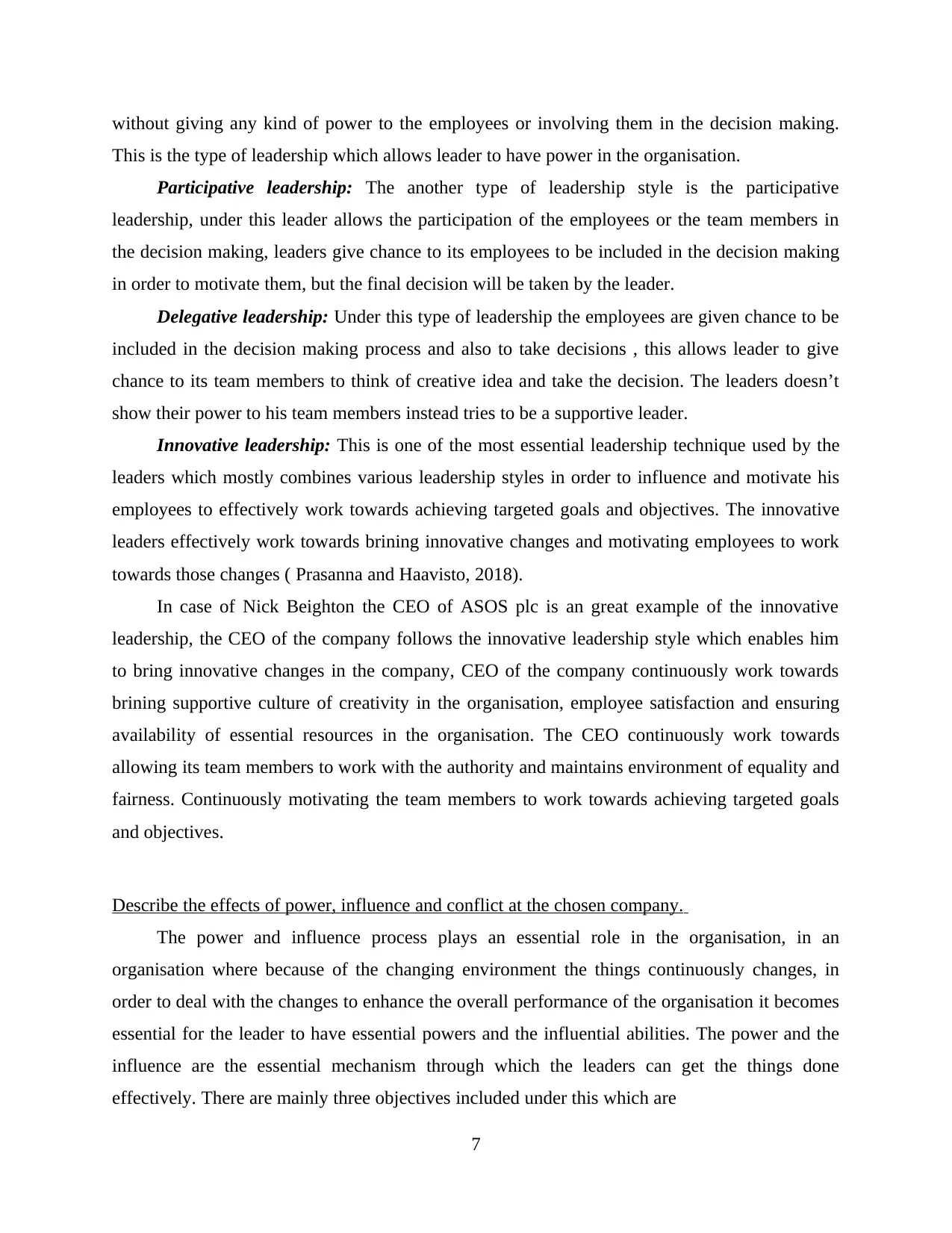
without giving any kind of power to the employees or involving them in the decision making.
This is the type of leadership which allows leader to have power in the organisation.
Participative leadership: The another type of leadership style is the participative
leadership, under this leader allows the participation of the employees or the team members in
the decision making, leaders give chance to its employees to be included in the decision making
in order to motivate them, but the final decision will be taken by the leader.
Delegative leadership: Under this type of leadership the employees are given chance to be
included in the decision making process and also to take decisions , this allows leader to give
chance to its team members to think of creative idea and take the decision. The leaders doesn’t
show their power to his team members instead tries to be a supportive leader.
Innovative leadership: This is one of the most essential leadership technique used by the
leaders which mostly combines various leadership styles in order to influence and motivate his
employees to effectively work towards achieving targeted goals and objectives. The innovative
leaders effectively work towards brining innovative changes and motivating employees to work
towards those changes ( Prasanna and Haavisto, 2018).
In case of Nick Beighton the CEO of ASOS plc is an great example of the innovative
leadership, the CEO of the company follows the innovative leadership style which enables him
to bring innovative changes in the company, CEO of the company continuously work towards
brining supportive culture of creativity in the organisation, employee satisfaction and ensuring
availability of essential resources in the organisation. The CEO continuously work towards
allowing its team members to work with the authority and maintains environment of equality and
fairness. Continuously motivating the team members to work towards achieving targeted goals
and objectives.
Describe the effects of power, influence and conflict at the chosen company.
The power and influence process plays an essential role in the organisation, in an
organisation where because of the changing environment the things continuously changes, in
order to deal with the changes to enhance the overall performance of the organisation it becomes
essential for the leader to have essential powers and the influential abilities. The power and the
influence are the essential mechanism through which the leaders can get the things done
effectively. There are mainly three objectives included under this which are
7
This is the type of leadership which allows leader to have power in the organisation.
Participative leadership: The another type of leadership style is the participative
leadership, under this leader allows the participation of the employees or the team members in
the decision making, leaders give chance to its employees to be included in the decision making
in order to motivate them, but the final decision will be taken by the leader.
Delegative leadership: Under this type of leadership the employees are given chance to be
included in the decision making process and also to take decisions , this allows leader to give
chance to its team members to think of creative idea and take the decision. The leaders doesn’t
show their power to his team members instead tries to be a supportive leader.
Innovative leadership: This is one of the most essential leadership technique used by the
leaders which mostly combines various leadership styles in order to influence and motivate his
employees to effectively work towards achieving targeted goals and objectives. The innovative
leaders effectively work towards brining innovative changes and motivating employees to work
towards those changes ( Prasanna and Haavisto, 2018).
In case of Nick Beighton the CEO of ASOS plc is an great example of the innovative
leadership, the CEO of the company follows the innovative leadership style which enables him
to bring innovative changes in the company, CEO of the company continuously work towards
brining supportive culture of creativity in the organisation, employee satisfaction and ensuring
availability of essential resources in the organisation. The CEO continuously work towards
allowing its team members to work with the authority and maintains environment of equality and
fairness. Continuously motivating the team members to work towards achieving targeted goals
and objectives.
Describe the effects of power, influence and conflict at the chosen company.
The power and influence process plays an essential role in the organisation, in an
organisation where because of the changing environment the things continuously changes, in
order to deal with the changes to enhance the overall performance of the organisation it becomes
essential for the leader to have essential powers and the influential abilities. The power and the
influence are the essential mechanism through which the leaders can get the things done
effectively. There are mainly three objectives included under this which are
7
Paraphrase This Document
Need a fresh take? Get an instant paraphrase of this document with our AI Paraphraser
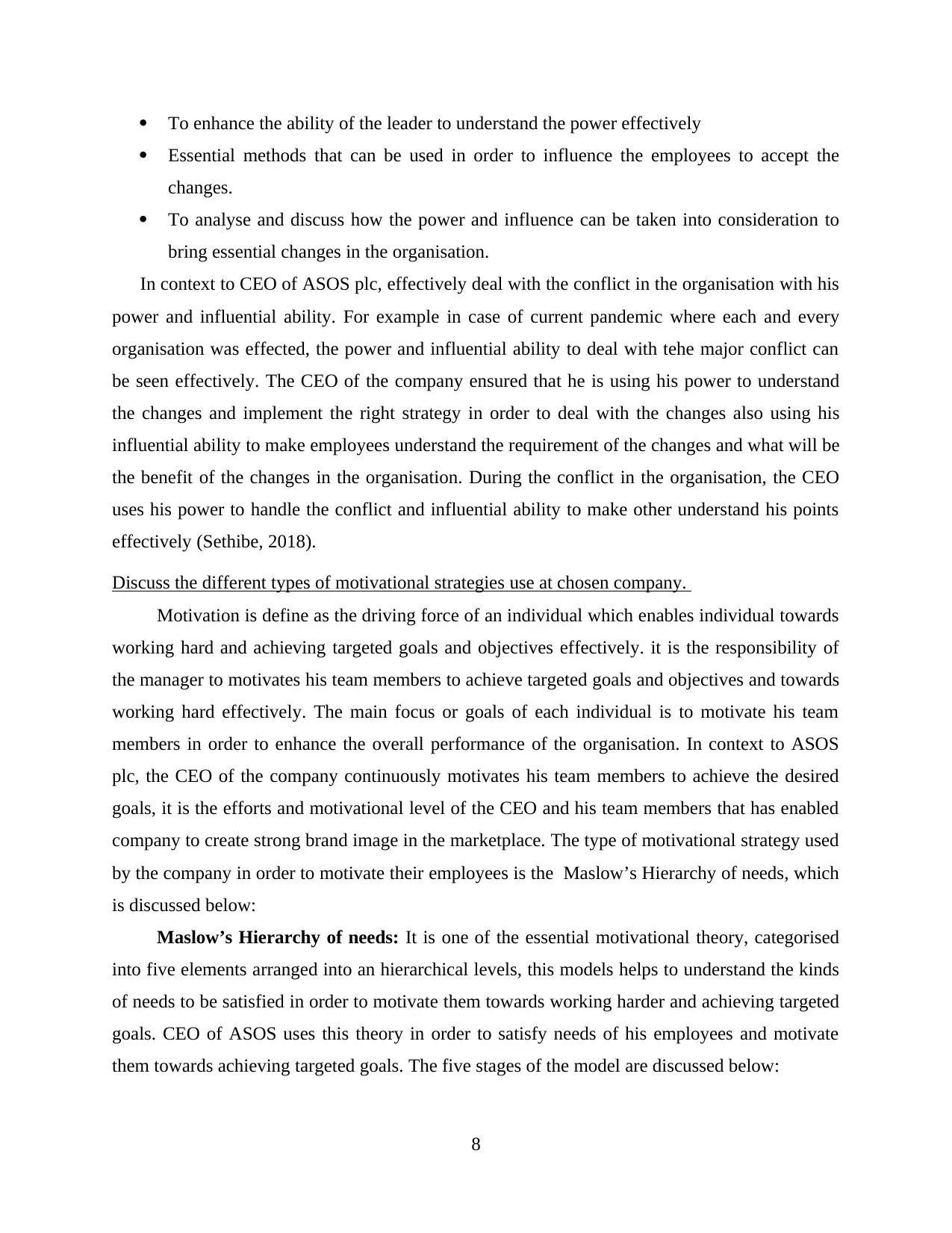
To enhance the ability of the leader to understand the power effectively
Essential methods that can be used in order to influence the employees to accept the
changes.
To analyse and discuss how the power and influence can be taken into consideration to
bring essential changes in the organisation.
In context to CEO of ASOS plc, effectively deal with the conflict in the organisation with his
power and influential ability. For example in case of current pandemic where each and every
organisation was effected, the power and influential ability to deal with tehe major conflict can
be seen effectively. The CEO of the company ensured that he is using his power to understand
the changes and implement the right strategy in order to deal with the changes also using his
influential ability to make employees understand the requirement of the changes and what will be
the benefit of the changes in the organisation. During the conflict in the organisation, the CEO
uses his power to handle the conflict and influential ability to make other understand his points
effectively (Sethibe, 2018).
Discuss the different types of motivational strategies use at chosen company.
Motivation is define as the driving force of an individual which enables individual towards
working hard and achieving targeted goals and objectives effectively. it is the responsibility of
the manager to motivates his team members to achieve targeted goals and objectives and towards
working hard effectively. The main focus or goals of each individual is to motivate his team
members in order to enhance the overall performance of the organisation. In context to ASOS
plc, the CEO of the company continuously motivates his team members to achieve the desired
goals, it is the efforts and motivational level of the CEO and his team members that has enabled
company to create strong brand image in the marketplace. The type of motivational strategy used
by the company in order to motivate their employees is the Maslow’s Hierarchy of needs, which
is discussed below:
Maslow’s Hierarchy of needs: It is one of the essential motivational theory, categorised
into five elements arranged into an hierarchical levels, this models helps to understand the kinds
of needs to be satisfied in order to motivate them towards working harder and achieving targeted
goals. CEO of ASOS uses this theory in order to satisfy needs of his employees and motivate
them towards achieving targeted goals. The five stages of the model are discussed below:
8
Essential methods that can be used in order to influence the employees to accept the
changes.
To analyse and discuss how the power and influence can be taken into consideration to
bring essential changes in the organisation.
In context to CEO of ASOS plc, effectively deal with the conflict in the organisation with his
power and influential ability. For example in case of current pandemic where each and every
organisation was effected, the power and influential ability to deal with tehe major conflict can
be seen effectively. The CEO of the company ensured that he is using his power to understand
the changes and implement the right strategy in order to deal with the changes also using his
influential ability to make employees understand the requirement of the changes and what will be
the benefit of the changes in the organisation. During the conflict in the organisation, the CEO
uses his power to handle the conflict and influential ability to make other understand his points
effectively (Sethibe, 2018).
Discuss the different types of motivational strategies use at chosen company.
Motivation is define as the driving force of an individual which enables individual towards
working hard and achieving targeted goals and objectives effectively. it is the responsibility of
the manager to motivates his team members to achieve targeted goals and objectives and towards
working hard effectively. The main focus or goals of each individual is to motivate his team
members in order to enhance the overall performance of the organisation. In context to ASOS
plc, the CEO of the company continuously motivates his team members to achieve the desired
goals, it is the efforts and motivational level of the CEO and his team members that has enabled
company to create strong brand image in the marketplace. The type of motivational strategy used
by the company in order to motivate their employees is the Maslow’s Hierarchy of needs, which
is discussed below:
Maslow’s Hierarchy of needs: It is one of the essential motivational theory, categorised
into five elements arranged into an hierarchical levels, this models helps to understand the kinds
of needs to be satisfied in order to motivate them towards working harder and achieving targeted
goals. CEO of ASOS uses this theory in order to satisfy needs of his employees and motivate
them towards achieving targeted goals. The five stages of the model are discussed below:
8
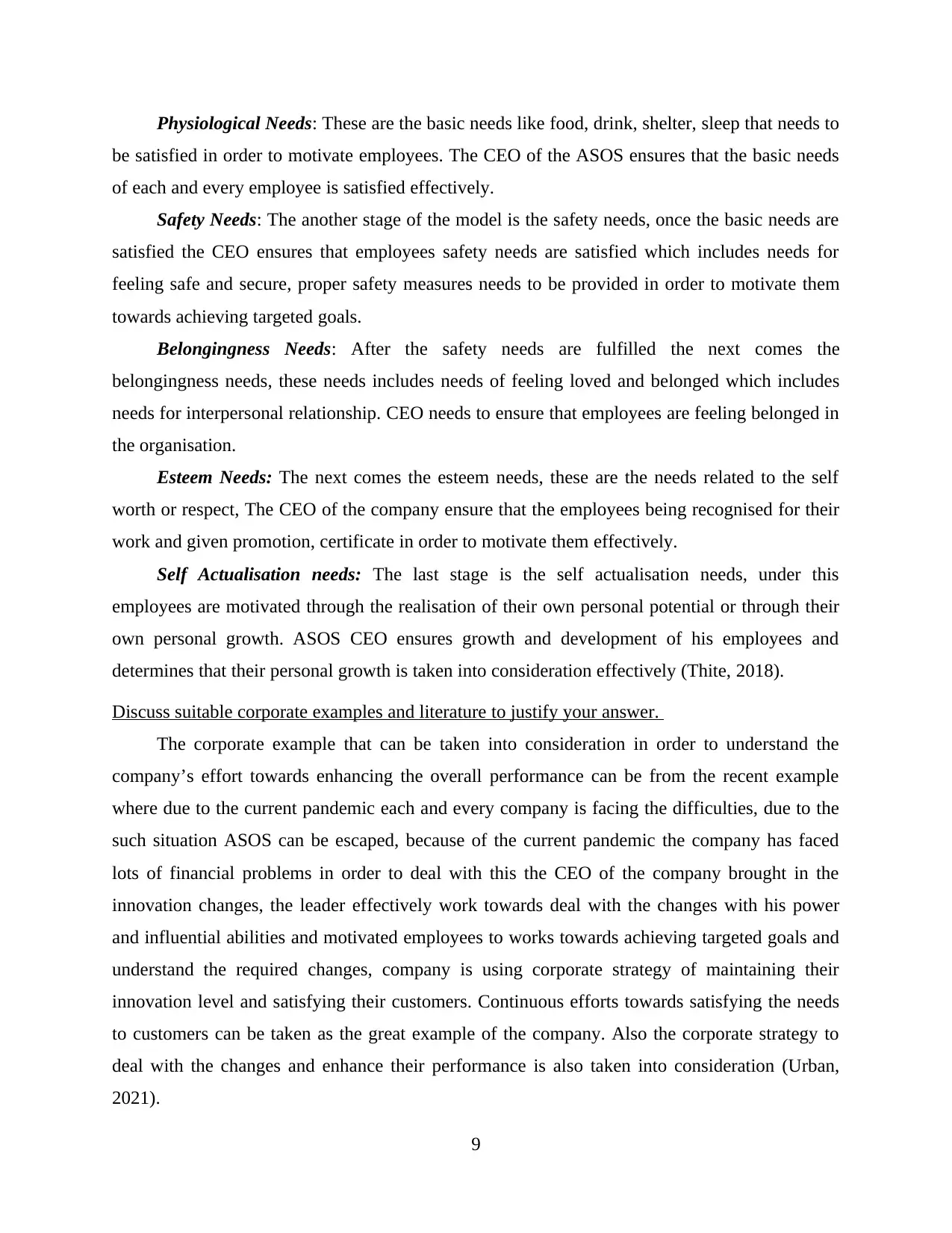
Physiological Needs: These are the basic needs like food, drink, shelter, sleep that needs to
be satisfied in order to motivate employees. The CEO of the ASOS ensures that the basic needs
of each and every employee is satisfied effectively.
Safety Needs: The another stage of the model is the safety needs, once the basic needs are
satisfied the CEO ensures that employees safety needs are satisfied which includes needs for
feeling safe and secure, proper safety measures needs to be provided in order to motivate them
towards achieving targeted goals.
Belongingness Needs: After the safety needs are fulfilled the next comes the
belongingness needs, these needs includes needs of feeling loved and belonged which includes
needs for interpersonal relationship. CEO needs to ensure that employees are feeling belonged in
the organisation.
Esteem Needs: The next comes the esteem needs, these are the needs related to the self
worth or respect, The CEO of the company ensure that the employees being recognised for their
work and given promotion, certificate in order to motivate them effectively.
Self Actualisation needs: The last stage is the self actualisation needs, under this
employees are motivated through the realisation of their own personal potential or through their
own personal growth. ASOS CEO ensures growth and development of his employees and
determines that their personal growth is taken into consideration effectively (Thite, 2018).
Discuss suitable corporate examples and literature to justify your answer.
The corporate example that can be taken into consideration in order to understand the
company’s effort towards enhancing the overall performance can be from the recent example
where due to the current pandemic each and every company is facing the difficulties, due to the
such situation ASOS can be escaped, because of the current pandemic the company has faced
lots of financial problems in order to deal with this the CEO of the company brought in the
innovation changes, the leader effectively work towards deal with the changes with his power
and influential abilities and motivated employees to works towards achieving targeted goals and
understand the required changes, company is using corporate strategy of maintaining their
innovation level and satisfying their customers. Continuous efforts towards satisfying the needs
to customers can be taken as the great example of the company. Also the corporate strategy to
deal with the changes and enhance their performance is also taken into consideration (Urban,
2021).
9
be satisfied in order to motivate employees. The CEO of the ASOS ensures that the basic needs
of each and every employee is satisfied effectively.
Safety Needs: The another stage of the model is the safety needs, once the basic needs are
satisfied the CEO ensures that employees safety needs are satisfied which includes needs for
feeling safe and secure, proper safety measures needs to be provided in order to motivate them
towards achieving targeted goals.
Belongingness Needs: After the safety needs are fulfilled the next comes the
belongingness needs, these needs includes needs of feeling loved and belonged which includes
needs for interpersonal relationship. CEO needs to ensure that employees are feeling belonged in
the organisation.
Esteem Needs: The next comes the esteem needs, these are the needs related to the self
worth or respect, The CEO of the company ensure that the employees being recognised for their
work and given promotion, certificate in order to motivate them effectively.
Self Actualisation needs: The last stage is the self actualisation needs, under this
employees are motivated through the realisation of their own personal potential or through their
own personal growth. ASOS CEO ensures growth and development of his employees and
determines that their personal growth is taken into consideration effectively (Thite, 2018).
Discuss suitable corporate examples and literature to justify your answer.
The corporate example that can be taken into consideration in order to understand the
company’s effort towards enhancing the overall performance can be from the recent example
where due to the current pandemic each and every company is facing the difficulties, due to the
such situation ASOS can be escaped, because of the current pandemic the company has faced
lots of financial problems in order to deal with this the CEO of the company brought in the
innovation changes, the leader effectively work towards deal with the changes with his power
and influential abilities and motivated employees to works towards achieving targeted goals and
understand the required changes, company is using corporate strategy of maintaining their
innovation level and satisfying their customers. Continuous efforts towards satisfying the needs
to customers can be taken as the great example of the company. Also the corporate strategy to
deal with the changes and enhance their performance is also taken into consideration (Urban,
2021).
9
⊘ This is a preview!⊘
Do you want full access?
Subscribe today to unlock all pages.

Trusted by 1+ million students worldwide
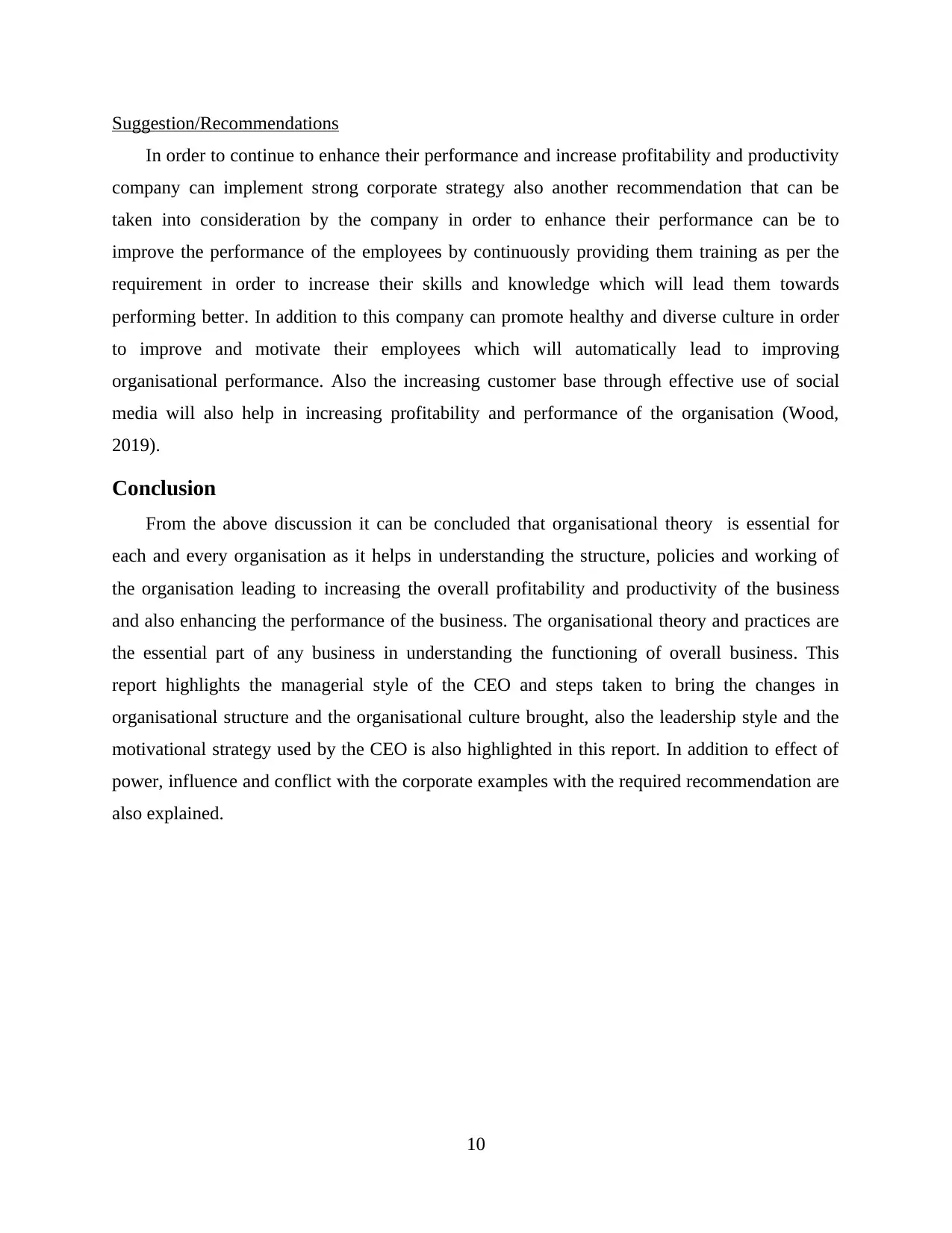
Suggestion/Recommendations
In order to continue to enhance their performance and increase profitability and productivity
company can implement strong corporate strategy also another recommendation that can be
taken into consideration by the company in order to enhance their performance can be to
improve the performance of the employees by continuously providing them training as per the
requirement in order to increase their skills and knowledge which will lead them towards
performing better. In addition to this company can promote healthy and diverse culture in order
to improve and motivate their employees which will automatically lead to improving
organisational performance. Also the increasing customer base through effective use of social
media will also help in increasing profitability and performance of the organisation (Wood,
2019).
Conclusion
From the above discussion it can be concluded that organisational theory is essential for
each and every organisation as it helps in understanding the structure, policies and working of
the organisation leading to increasing the overall profitability and productivity of the business
and also enhancing the performance of the business. The organisational theory and practices are
the essential part of any business in understanding the functioning of overall business. This
report highlights the managerial style of the CEO and steps taken to bring the changes in
organisational structure and the organisational culture brought, also the leadership style and the
motivational strategy used by the CEO is also highlighted in this report. In addition to effect of
power, influence and conflict with the corporate examples with the required recommendation are
also explained.
10
In order to continue to enhance their performance and increase profitability and productivity
company can implement strong corporate strategy also another recommendation that can be
taken into consideration by the company in order to enhance their performance can be to
improve the performance of the employees by continuously providing them training as per the
requirement in order to increase their skills and knowledge which will lead them towards
performing better. In addition to this company can promote healthy and diverse culture in order
to improve and motivate their employees which will automatically lead to improving
organisational performance. Also the increasing customer base through effective use of social
media will also help in increasing profitability and performance of the organisation (Wood,
2019).
Conclusion
From the above discussion it can be concluded that organisational theory is essential for
each and every organisation as it helps in understanding the structure, policies and working of
the organisation leading to increasing the overall profitability and productivity of the business
and also enhancing the performance of the business. The organisational theory and practices are
the essential part of any business in understanding the functioning of overall business. This
report highlights the managerial style of the CEO and steps taken to bring the changes in
organisational structure and the organisational culture brought, also the leadership style and the
motivational strategy used by the CEO is also highlighted in this report. In addition to effect of
power, influence and conflict with the corporate examples with the required recommendation are
also explained.
10
Paraphrase This Document
Need a fresh take? Get an instant paraphrase of this document with our AI Paraphraser
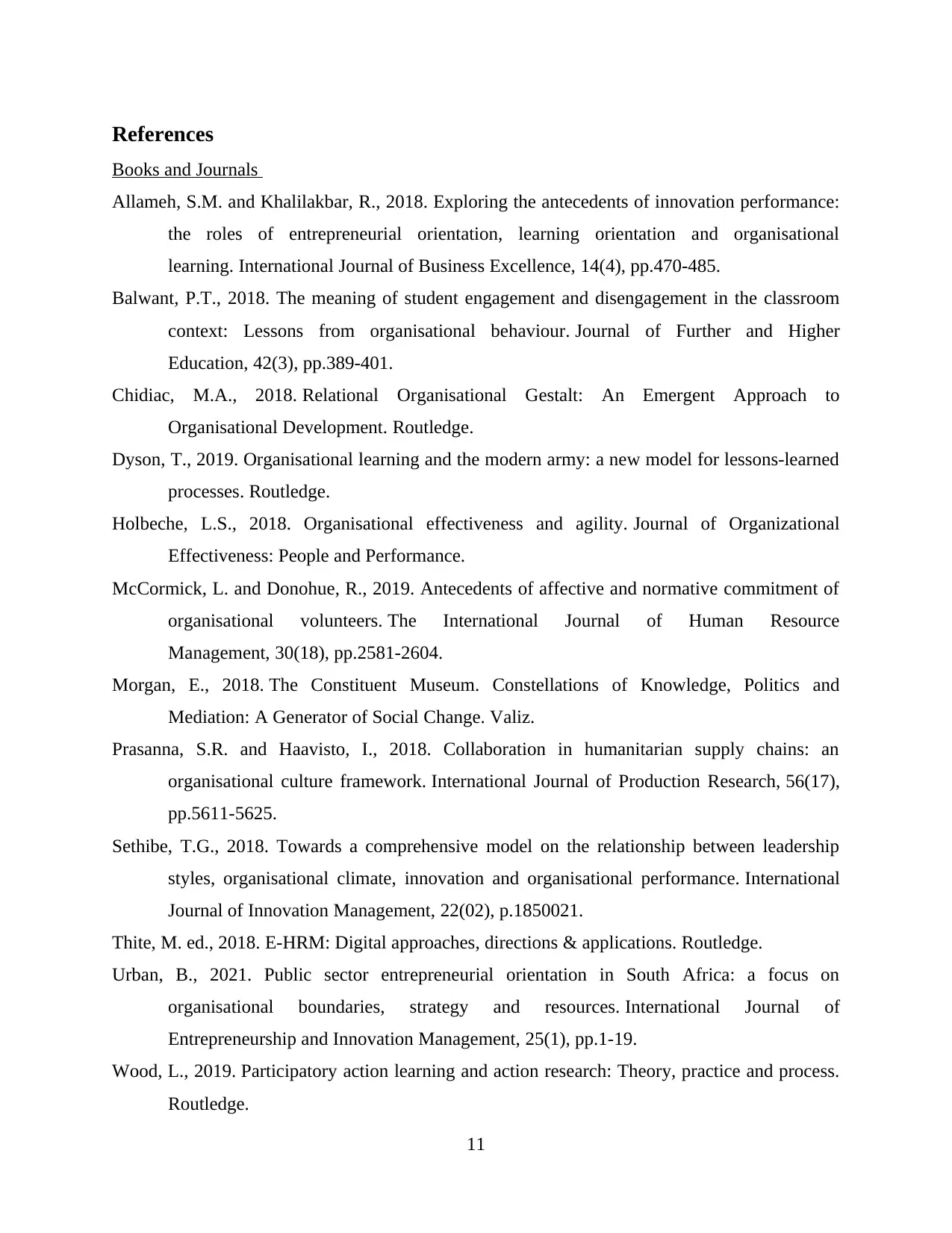
References
Books and Journals
Allameh, S.M. and Khalilakbar, R., 2018. Exploring the antecedents of innovation performance:
the roles of entrepreneurial orientation, learning orientation and organisational
learning. International Journal of Business Excellence, 14(4), pp.470-485.
Balwant, P.T., 2018. The meaning of student engagement and disengagement in the classroom
context: Lessons from organisational behaviour. Journal of Further and Higher
Education, 42(3), pp.389-401.
Chidiac, M.A., 2018. Relational Organisational Gestalt: An Emergent Approach to
Organisational Development. Routledge.
Dyson, T., 2019. Organisational learning and the modern army: a new model for lessons-learned
processes. Routledge.
Holbeche, L.S., 2018. Organisational effectiveness and agility. Journal of Organizational
Effectiveness: People and Performance.
McCormick, L. and Donohue, R., 2019. Antecedents of affective and normative commitment of
organisational volunteers. The International Journal of Human Resource
Management, 30(18), pp.2581-2604.
Morgan, E., 2018. The Constituent Museum. Constellations of Knowledge, Politics and
Mediation: A Generator of Social Change. Valiz.
Prasanna, S.R. and Haavisto, I., 2018. Collaboration in humanitarian supply chains: an
organisational culture framework. International Journal of Production Research, 56(17),
pp.5611-5625.
Sethibe, T.G., 2018. Towards a comprehensive model on the relationship between leadership
styles, organisational climate, innovation and organisational performance. International
Journal of Innovation Management, 22(02), p.1850021.
Thite, M. ed., 2018. E-HRM: Digital approaches, directions & applications. Routledge.
Urban, B., 2021. Public sector entrepreneurial orientation in South Africa: a focus on
organisational boundaries, strategy and resources. International Journal of
Entrepreneurship and Innovation Management, 25(1), pp.1-19.
Wood, L., 2019. Participatory action learning and action research: Theory, practice and process.
Routledge.
11
Books and Journals
Allameh, S.M. and Khalilakbar, R., 2018. Exploring the antecedents of innovation performance:
the roles of entrepreneurial orientation, learning orientation and organisational
learning. International Journal of Business Excellence, 14(4), pp.470-485.
Balwant, P.T., 2018. The meaning of student engagement and disengagement in the classroom
context: Lessons from organisational behaviour. Journal of Further and Higher
Education, 42(3), pp.389-401.
Chidiac, M.A., 2018. Relational Organisational Gestalt: An Emergent Approach to
Organisational Development. Routledge.
Dyson, T., 2019. Organisational learning and the modern army: a new model for lessons-learned
processes. Routledge.
Holbeche, L.S., 2018. Organisational effectiveness and agility. Journal of Organizational
Effectiveness: People and Performance.
McCormick, L. and Donohue, R., 2019. Antecedents of affective and normative commitment of
organisational volunteers. The International Journal of Human Resource
Management, 30(18), pp.2581-2604.
Morgan, E., 2018. The Constituent Museum. Constellations of Knowledge, Politics and
Mediation: A Generator of Social Change. Valiz.
Prasanna, S.R. and Haavisto, I., 2018. Collaboration in humanitarian supply chains: an
organisational culture framework. International Journal of Production Research, 56(17),
pp.5611-5625.
Sethibe, T.G., 2018. Towards a comprehensive model on the relationship between leadership
styles, organisational climate, innovation and organisational performance. International
Journal of Innovation Management, 22(02), p.1850021.
Thite, M. ed., 2018. E-HRM: Digital approaches, directions & applications. Routledge.
Urban, B., 2021. Public sector entrepreneurial orientation in South Africa: a focus on
organisational boundaries, strategy and resources. International Journal of
Entrepreneurship and Innovation Management, 25(1), pp.1-19.
Wood, L., 2019. Participatory action learning and action research: Theory, practice and process.
Routledge.
11
1 out of 11
Related Documents
Your All-in-One AI-Powered Toolkit for Academic Success.
+13062052269
info@desklib.com
Available 24*7 on WhatsApp / Email
![[object Object]](/_next/static/media/star-bottom.7253800d.svg)
Unlock your academic potential
Copyright © 2020–2025 A2Z Services. All Rights Reserved. Developed and managed by ZUCOL.




